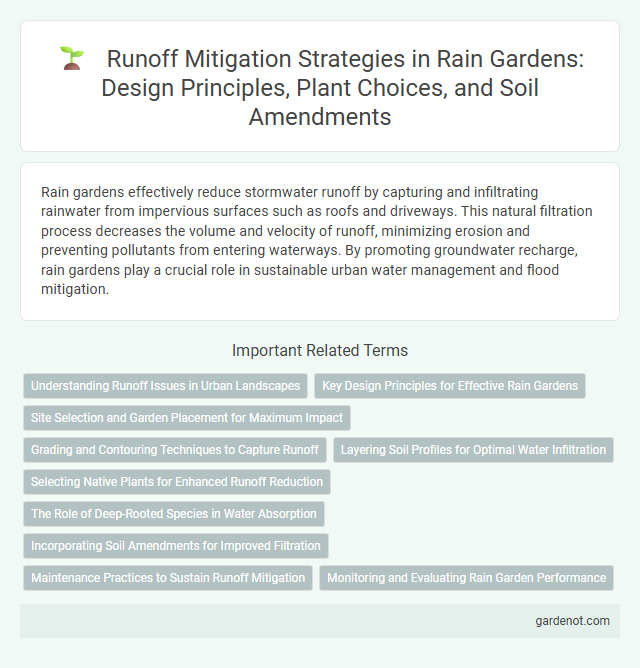Rain gardens effectively reduce stormwater runoff by capturing and infiltrating rainwater from impervious surfaces such as roofs and driveways. This natural filtration process decreases the volume and velocity of runoff, minimizing erosion and preventing pollutants from entering waterways. By promoting groundwater recharge, rain gardens play a crucial role in sustainable urban water management and flood mitigation.
Understanding Runoff Issues in Urban Landscapes
Urban landscapes experience increased runoff due to impervious surfaces like asphalt and concrete, which prevent natural infiltration and elevate flood risks. Rain gardens capture and filter stormwater runoff, reducing pollutant loads and alleviating strain on municipal drainage systems. By promoting groundwater recharge and controlling peak flow rates, rain gardens effectively mitigate urban runoff challenges.
Key Design Principles for Effective Rain Gardens
Effective rain gardens utilize strategic grading to direct runoff flow, ensuring water infiltrates the soil rather than pooling or flowing away. Selecting native, deep-rooted plants enhances soil permeability and stabilizes the garden bed, promoting efficient water absorption. Incorporating a berm or outlet structure controls overflow, preventing erosion and managing excess runoff during heavy rainfall events.
Site Selection and Garden Placement for Maximum Impact
Choosing an ideal site for a rain garden involves targeting areas with high runoff concentration such as downspouts, driveways, or low-lying landscape depressions. Proper garden placement ensures efficient infiltration by locating the garden at least 10 feet away from building foundations and avoiding steep slopes to prevent erosion. Incorporating native plants with deep root systems further enhances runoff mitigation by increasing soil permeability and water absorption capacity.
Grading and Contouring Techniques to Capture Runoff
Grading and contouring techniques strategically shape the landscape to slow, direct, and capture stormwater runoff within a rain garden, preventing erosion and promoting infiltration. By creating subtle depressions and slopes that follow natural land contours, these methods optimize water retention and enhance pollutant filtration. Properly designed grading reduces peak flow rates and supports groundwater recharge, making it a critical component of effective runoff mitigation.
Layering Soil Profiles for Optimal Water Infiltration
Layering soil profiles in rain gardens enhances runoff mitigation by optimizing water infiltration and promoting groundwater recharge. Incorporating a mix of sandy loam, compost, and gravel layers increases permeability while filtering pollutants effectively. Proper stratification supports plant health and reduces surface runoff, preventing erosion and flooding in urban settings.
Selecting Native Plants for Enhanced Runoff Reduction
Selecting native plants such as switchgrass (Panicum virgatum), purple coneflower (Echinacea purpurea), and blue flag iris (Iris versicolor) enhances runoff reduction by promoting deep root systems that increase soil infiltration. These plants improve water absorption and slow surface runoff, reducing erosion and filtering pollutants before they reach waterways. Utilizing native species also supports local ecosystems, ensuring rain gardens effectively manage stormwater while sustaining biodiversity.
The Role of Deep-Rooted Species in Water Absorption
Deep-rooted species in rain gardens significantly enhance runoff mitigation by improving soil permeability and increasing water infiltration rates. Their extensive root systems create channels that allow excess rainwater to penetrate deeper into the soil, reducing surface runoff and minimizing erosion. These plants also promote soil microbial activity, which further aids in breaking down pollutants and improving overall water quality.
Incorporating Soil Amendments for Improved Filtration
Incorporating soil amendments such as compost and biochar enhances rain garden performance by increasing soil porosity and microbial activity, which improves runoff filtration and pollutant breakdown. These organic materials boost water retention capacity, reducing surface runoff volume and promoting groundwater recharge. Enhanced soil structure from amendments also supports healthier vegetation growth, further stabilizing the soil and preventing erosion.
Maintenance Practices to Sustain Runoff Mitigation
Regular maintenance practices such as removing sediment buildup, controlling invasive vegetation, and inspecting inflow and outflow structures are essential to sustain runoff mitigation in rain gardens. Proper pruning and mulching help maintain soil permeability and plant health, ensuring efficient water absorption and filtration. Periodic evaluation and repair of erosion points prevent system failures, optimizing long-term runoff reduction and water quality improvement.
Monitoring and Evaluating Rain Garden Performance
Effective runoff mitigation relies on consistent monitoring and evaluating rain garden performance through metrics such as infiltration rates, soil moisture levels, and pollutant removal efficiency. Installing sensors and conducting periodic water quality tests help quantify the garden's capacity to absorb and filter stormwater runoff. Data collected informs maintenance needs and design improvements, optimizing the rain garden's ability to reduce localized flooding and improve water quality over time.
Runoff mitigation Infographic

 gardenot.com
gardenot.com